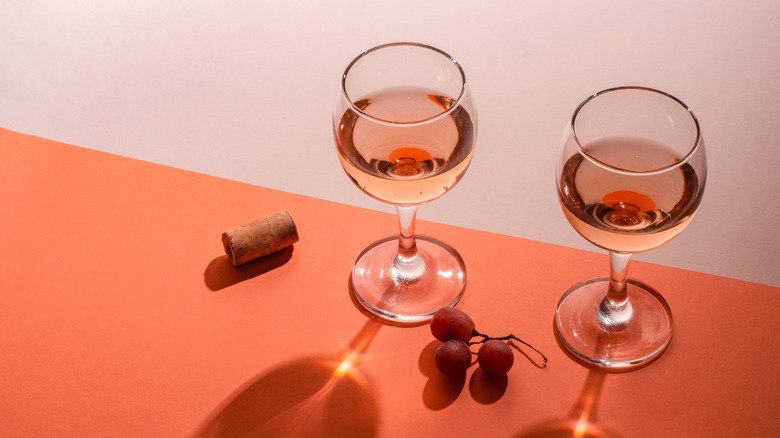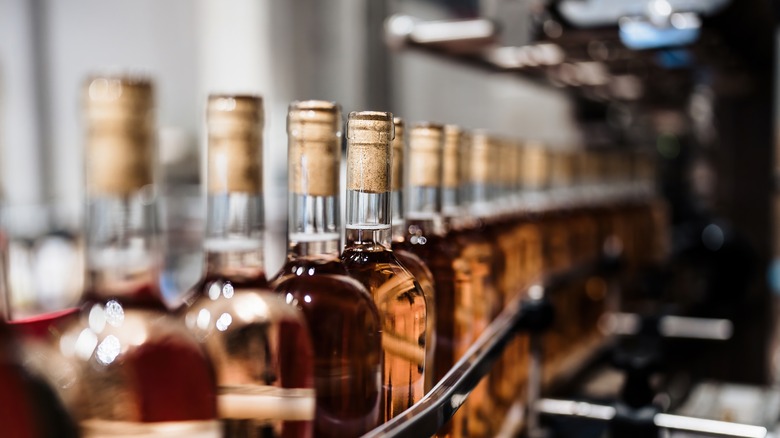Sorry, But Sulfite-Free Wine Isn't A Real Thing
As you browse the wine bottles at your local grocery store, you'll notice a variety of label claims vying for your attention. From biodynamic to barrel-aged, the options are endless. The term 'sulfite-free' on a wine label can pose a dilemma — is it just a trendy buzzword or something you should care about? It may be surprising to discover that despite the increasing demand for sulfite-free wines, no wine can be completely sulfite-free.
The rising interest in sulfite-free wines mirrors growing concerns about food additives. Some individuals believe that additives like sulfites in wine cause adverse reactions like skin redness and headaches. While research published in Allergol Select suggests that about 10% of people are hypersensitive to alcohol, according to the FDA, only 1% of people are sensitive to sulfites, and true sulfite allergies are even less common. An allergic reaction to sulfites might include symptoms like facial or throat swelling, hives, and digestive issues. In extremely rare cases, it can lead to anaphylaxis. However, most unpleasant reactions to alcohol, including flushed skin, headaches, and stomach upset — particularly the morning after — probably have more to do with the effects of alcohol itself, such as dehydration.
Understanding sulfites in wine
Sulfites, also known as sulfur dioxide molecules, are found both naturally and used as additives in various foods and medicines. They function as antioxidants, which means they slow down oxidative damage — similar to how a squeeze of lemon juice prevents sliced apples from browning. Additionally, sulfites serve as preservatives and possess antibacterial properties. They are a fixture in many everyday foods, including jam, maple syrup, baked goods, canned foods, dried fruit, shrimp, and potato chips.
In the world of winemaking, sulfites play a crucial role. All wine undergoes fermentation, a process that naturally produces sulfites. Winemakers often add extra sulfites to help preserve the wine's optimal state, safeguarding its flavor and color. Essentially, this allows winemakers to hit the "pause" button on the fermentation process at just the right moment. Without the use of sulfites, wine is more susceptible to over-oxidation, potentially transforming it into an astringent, vinegary substance you wouldn't want to drink.
Navigating health and quality concerns in the world of wine sulfites
Although most people are safe from sulfite sensitivity, being an informed shopper is still empowering. FDA regulations mandate that foods with sulfites exceeding 10 parts per million (ppm) be labeled accordingly. Sulfite levels below this threshold level have not been linked to adverse health reactions, even in the sulfite-sensitive. For individuals with sulfite sensitivity, experts recommend consulting a healthcare professional and potentially steering clear of foods high in sulfites, including wine and many packaged items. While wine is high in sulfites (over 100 ppm), so are foods like sauerkraut and dried fruit. Moderate sulfite levels (over 50 ppm) are found in grape juice, maraschino cherries, and wine vinegar.
It's important to remember that some sulfites naturally occur in winemaking, regardless of whether they are added intentionally. If you're after the lowest sulfite levels, consider organic and biodynamic wines, which typically don't have added sulfites and often carry the 'sulfite-free' label, meeting the FDA's threshold. However, these wines might not last as long on your shelf due to their reliance on natural preservatives, so it's best to uncork and drink them shortly after buying them. Opting for red wines over white or rosé is also an option, as the tannins (polyphenols from grape skins) in red wines serve as natural preservatives, reducing the need for sulfites. In the end, sulfites are likely nothing to fear, so you can feel more confident the next time you peruse for wines.


